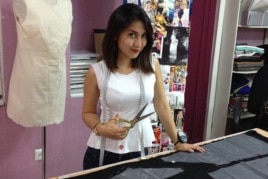Central Asia's Controversial Fashion Statements
ome people say you can tell a lot about a person by the way they dress. You can “dress for success” or believe “clothes make the man.”
In March, the subject of dress came up in three Central Asian countries, in one case because the clothing was “foreign” Islamic, in another too risque/Western, and in a third as a suggestion to honor the past.
We begin in Tajikistan, site of the most recent intrusion by the “fashion police,” literally.
During a celebration to mark Mother’s Day (formally International Women’s Day), it seems President Emomali Rahmon was upset by the appearance of several women dressed in long black robes traditionally worn by women in Islamic countries further south and west of Tajikistan. Some of the women reportedly wore veils, a piece of clothing that has caused a huge uproar in Central Asia for many years.
Rahmon expressed his displeasure, saying it was not “in keeping with Tajik culture and traditions.” He explained, “Our people have never worn black clothing. It’s not acceptable to wear black at traditional ceremonies,” adding, “Even clothing for mourning is not monotone black.”
The president’s disapproval spurred officials into action. On March 28, First Deputy Interior Minister Abdurahmon Alamshozoda chaired a meeting in Dushanbe with chiefs of police and other top law- enforcement officials from around the country. Alamshozoda told them to be on the lookout for women wearing “foreign clothes” and to engage in “explanatory work among the population.”
That seems to mean telling young women not to dress like Muslim women in other countries do.
Rajabboy Ahmadzoda, the mayor of Khujand, Tajikistan’s second-largest city, told RFE/RL’s Tajik Service, known locally as Ozodi, that he had given the instructions to local law enforcement and suggested “every Tajik girl should honor national traditions in their clothing.”
The Khujand city administration gave orders to raid stores and stalls selling “clothes made in Iranian or Afghan style.”
In Uzbekistan, the problem was “immodest” garb. Singer Lola Yuldasheva gave a performance at the end of February and her choice of attire caught the attention of Uzbeknavo. Uzbeknavo is the state agency in charge of giving licenses to performers -- or banning them from performing.
Uzbeknavo summoned Yuldasheva and explained the dress she wore during the February 24 concert “conflicts with the national mentality.” She was given a warning not to wear such an outfit during future performances.

Uzbek singer Lola Yoldosheva (left)On the eve of Norouz, March 21, Uzbeknavo issued a directive that female performers were no longer to wear clothing that exposed their shoulders or legs, that they were not to appear “half-naked” at public events, and that they were not to include any sexually suggestive moves on stage.
In order to avoid a repetition of the “scandalous” incident with Yuldasheva, “all female singers are to be seriously warned ahead of concerts” about their attire and “manner.”
RFE/RL’s Uzbek Service, known locally as Ozodlik,contacted the maker of Yuldasheva’s dress, 31-year-old Zulfiya Sulton. She said the dress was inspired by the “spirit of the song.” Sulton told Ozodlik, “I don’t see anything excessive and consider the criticism to be misplaced.”

Designer Zulfiya SultonSulton said she designs clothes for stage performers, “not librarians or students at the Islamic college.”
Uzbek state television, the only television in Uzbekistan, has been regularly running programs about “foreign” or “alien” clothing for many years now and criticizes both “Western” styles of dress and Islamic clothing from other Muslims regions.
There is also a movement now in Kyrgyzstan, small so far, against revealing Western clothing being worn by young women. Those who criticize such apparel advise a return to the more traditional clothing of Kyrgyz women.
And the subject of traditional garb brings us to Kazakhstan, where “historian, writer, and propagandist of the great steppe,” Arman Nurmukhanbetov, told Tengrinews. that Kazakhstan needs to introduce a Day of Kazakh Dress. Nurmukhanbetov “together with a group of enthusiasts” has launched a social-network campaign to gain support for the idea.
Nurmukhanbetov wishes that the style of clothing Kazakhstan’s “ancestors wore over the course of thousands of years” should be honored and publicly displayed one day a year, which he proposed be “the last Friday of April, May, or September.”
The authorities’ attention to fashion is part of the search for -- or quest to invent -- a national identity. The governments of all five Central Asian states have been working on their national identities since the first days of independence in late 1991.
Many of the officials in Central Asia say that wearing the veil, or hijab, is not a custom of the region. Among some of Central Asia’s people it might not be -- the traditionally nomadic cultures, for example -- but those familiar with Central Asian history during the Soviet era will know about “hujum,” the forced unveiling of women in Central Asia, particularly Uzbekistan.
The Communist Party looked on the veil as a sign of the “backward and primitive”* people of Central Asia and, on International Women’s Day -- March 8, 1927 -- publicly banned women from wearing them.
The communist government forced women to take off their veil, on some occasions at gunpoint, and some of the women who did were killed by local men.
But most assuredly, some women in Central Asia did wear the veil prior to the arrival of the Russians.
Last, and certainly not least, almost every example above concerns how women dress. And the people articulating this “traditional” fashion sense are all men wearing Western suits to the office.
The traditional patriarchal system of Central Asia seems to be in no danger.